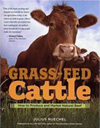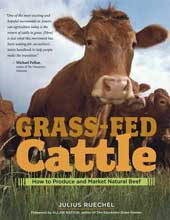Picture Credit score: dollen
“When beef is marketed as ‘grass fed beef,’ would not that routinely suggest that the cattle had been raised utilizing a pasture-based manufacturing technique?”
On this article I’m going to reply one other of the frequently asked questions I get from farmers and beef shoppers about grass fed beef.
From a advertising standpoint, “Grass-fed beef” merely signifies that the meat was produced on a food plan primarily consisting of grass and was completed with out grain. That is it.
Nevertheless, this advertising label just isn’t restricted to a single ‘one-size-fits-all’ farming technique that should be utilized by all farmers to supply grass-fed beef.
When the USDA developed their advertising commonplace for what it means for beef to qualify as “grass fed”, they deliberately didn’t handle HOW to supply it, as a result of they acknowledge that there will likely be many alternative farming methods used to supply grass fed beef.
This broad definition is an efficient factor, as a result of it permits farmers the liberty to innovate and discover extra environment friendly and cost-effective methods to supply beef for the grass fed market, which finally advantages each shoppers and farmers alike.
Nevertheless, it additionally units up the potential for confusion as each shoppers and farmers could think about a really totally different image of how cattle are raised for the grass fed beef market than what is definitely utilized by totally different farmers.
Replace: On January sixteenth, 2016, the USDA made the decision to withdraw their Grass Fed Marketing Claim standard.
The numerous farming methods of grass fed beef
There isn’t a one single ‘proper’ method to produce grass fed beef – there are numerous attainable methods all resulting in the identical vacation spot.
The pasture-based grass fed farming methods mentioned in my e-book, Grass Fed Cattle: how to produce and market natual beef, and on my website are merely one method to produce grass fed beef. They’re primarily based on my experiences and are designed to harness as many ecological benefits as attainable as a means of decreasing prices and making a seamless and cohesive manufacturing technique.
However they’re actually not the one method to produce a marketable grass fed product.
There will likely be many different modern grass fed farming methods – and I encourage different farmers to share their profitable methods by way of the contact form.
A few of these methods will profit everybody within the trade, no matter local weather or geographic location. Others could also be extra regional, local weather particular, or solely tailor-made to very particular producers. And a few methods could shock you as a result of they could look nothing like the image that you could have in your thoughts about how grass-fed beef needs to be produced.
What about ‘grass fed beef’ produced in Grass Fed Feedlots…!?!
As shocking as it might appear, grass fed beef CAN even be produced by confining cattle in a feedlot and feeding them any grass or legume food plan that doesn’t comprise any grain, corresponding to hay, silage, and even freshly-cut grass delivered to the cattle every day. This isn’t a fictional instance – some farmers actually do use this technique to supply grassfed beef.
Beef produced in these grass fed feedlots would nonetheless be thought of grass fed in response to the USDA definition. And it might nonetheless comprise all of the well being benefits of choosing a grass fed instead of a grain fed beef product.
But many readers will take subject with beef produced in a ‘grass-fed feedlot’ as a result of it conflicts with their concept of what grass fed beef is all about.
Nor are these grass fed feedlots capable of benefit from all of the potential cost-savings of utilizing pasture-based grass fed manufacturing methods, corresponding to letting the cattle harvest their very own feed in a daily pasture rotation.
However that’s the level – the USDA grass fed advertising label is concerning the food plan that the cattle are on, not whether or not the cattle are standing in a pasture or feed pen. Neither is it about whether or not the cattle graze the grass themselves or whether or not a forage harvester and feed wagon brings it to the cattle feed bunk.
If we, as shoppers, need beef to be produced in a selected manufacturing system, then it’s our duty to ask our farmers concerning the particulars of their manufacturing technique.
Ought to we create a single ‘standardized’ grass fed farming technique?
Creating guidelines for a single ‘standardized’ grass fed beef farming technique along with the USDA advertising definition is neither possible, nor fascinating.
To start with, how do you realistically draw the road between one farmer’s winter feed pen and one other farmer’s grass fed feedlot?
Some pasture-based methods, like year-round grazing (i.e. winter grazing), usually are not proper for everybody. So it actually wouldn’t be proper to exclude beef which is fed an all-forage food plan in a feed pen simply because the local weather or farmer’s expertise ranges or the farm’s enterprise construction usually are not arrange for winter grazing.
And from a dietary standpoint, it’s unlikely that the meat from cattle that graze by way of deep snow in a dormant winter pasture goes to be nutritionally distinct from beef from cattle which can be fed hay and silage through the winter. Neither is it probably that pasture-finished beef goes to be nutritionally totally different than beef from cattle which can be fattened in a grass fed feedlot on a food plan of recent grass delivered every day of their feed bunk. These totally different farming methods will have an effect on the farmers’ manufacturing prices (BIG TIME!), however not the meat shopper since both alternative may have the well being benefits of choosing grass fed instead of a grainfed beef product.
In addition to, do we actually wish to give somebody – presumably some politician – the duty of standardizing the methods that can be utilized for grass fed manufacturing, whereas stifling all of the innovation and experimentation that grass fed farmers use day-after-day to search out cheaper higher methods of manufacturing beef for us? The ensuing rule-book could be primarily based on political/ideological biases, local weather and geographic presumptions, lobbyist connections, and the way these guidelines would sound to the media after they report them to the voting public.
“Watch out what you ask for – you simply would possibly get it good and exhausting…”
I favor the USDA’s broad generic advertising commonplace for grass fed beef mixed with the liberty for shoppers to ask their very own questions and select the farmers whose farmers methods match their private visions of what grass-fed beef means to them.
Innovation is a bumpy path. Strategy sudden farming methods with tolerance and curiosity, and rejoice that you’ve got the liberty to judge the numerous totally different decisions to search out the selection that’s best for you.
Competitors and the liberty to experiment, not inflexible guidelines, is what is going to drive this trade ahead.
By leaving room within the ‘grass fed beef’ marking label for a variety of manufacturing methods – together with grass fed feedlots – we give our farmers the liberty to search out modern methods to enhance manufacturing effectivity on their grass fed cattle farms, which is able to assist enhance the availability of grass fed beef in the marketplace whereas decreasing prices to shoppers.
By cultivating a spirit of openness in direction of a variety of grass fed farming methods – together with grass fed feedlots – it ensures that farmers are proud and desirous to share with each clients and different farmers what they’re doing on their farms – regardless of how totally different it might have a look at first look to what one other farmer is doing. This leaves shoppers with the liberty to decide on for themselves what product will likely be proper for them. And it ensures that farmers can be taught from each other – in spite of everything, the better the variations between farming methods, the extra there’s to be taught from each other.
…
So, the brief reply is that grass-fed beef is the tip product, however that there are numerous paths to succeed in that finish product.
Whereas it might be tempting to attempt to create a standardized ‘grass-fed manufacturing system’, I firmly consider that each shoppers and the trade as an entire will profit much more by encouraging innovation and competitors and by retaining the liberty to supply grass fed beef in many alternative methods, even when that signifies that some grassfed beef supplied on the market has not been produced in a pasture-based farming system that matches your imaginative and prescient of what grass-fed beef is all about.
As a substitute, rejoice that we have now the liberty of alternative in what we purchase, and get pleasure from asking for extra particulars about the place and the way your beef was produced. Dig deeper than the label and discover out the steps your farmer used to supply your beef.
Associated Articles:
(Disclosure: I get commissions for purchases made utilizing Amazon hyperlinks in my submit.) And while you’re prepared to start out planning your cattle farm, try my e-book: Grass-Fed Cattle: The best way to Produce and Market Pure Beef. Use the hyperlinks beneath to discover my e-book and skim opinions on Amazon: 
|
Trending Merchandise

ZuPreem FruitBlend Bird Pellets, Daily Bird F...

ZuPreem Sensible Seed Bird Food, Parakeet, Bu...

Kaytee Forti-Diet Egg-Cite Parakeet Pet Bird ...

Best Nest Wellness Mama Bird Probiotics ̵...

Kaytee Fiesta Macaw Food, Nutritious and Fun ...

Pet Eye Cream Health for Dogs, Cats, Cattle, ...






